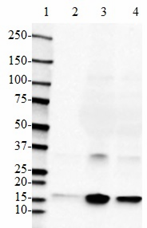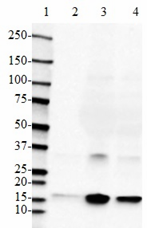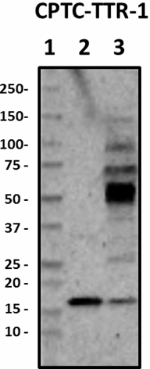- Clone
- CPTC-TTR-1 (See other available formats)
- Regulatory Status
- RUO
- Other Names
- PALB, ATTR, Prealbumin, TBPA
- Isotype
- Mouse IgG2a, κ
- Ave. Rating
- Submit a Review
- Product Citations
- publications

-

Western blot of purified anti-Transthyretin antibody (clone CPTC-TTR-1). Lane 1: Molecular weight marker; Lane 2:50 ng of recombinant human transthyretin; Lane 3:80 µg of human plasma; Lane 4:16 µg of human plasma. The blot was incubated with 1.0 µg/mL of the primary antibody overnight at 4°C, followed by incubation with HRP-labeled goat anti-mouse IgG (Cat. No. 405306). Enhanced chemiluminescence (Cat. No. 426302) was used as the detection system.
| Cat # | Size | Price | Quantity Check Availability | Save | ||
|---|---|---|---|---|---|---|
| 853001 | 25 µg | £77 | ||||
| 853002 | 100 µg | £197 | ||||
Transthyretin (TTR) is a carrier protein capable of transporting thyroid hormones in the plasma and cerebrospinal fluid, and retinol (vitamin A) in the plasma. TTR can form aberrant insoluble amyloid fibrils that primarily deposit in a patient’s heart and/or peripheral nerves. The wild-type protein is associated with senile systemic amyloidosis (SSA) and is typically diagnosed in men over 70 years-old. Single or double mutations in TTR are primarily associated with familial amyloidotic polyneuropathy (FAP) or familial amyloid cardiopathy (FAC), affecting younger patients (in their 30s).Clinical symptoms of TTR amyloidosis have historically been attributed to fibrils, but recent experimental evidence indicates that soluble TTR aggregates are also pathogenic.
Product DetailsProduct Details
- Verified Reactivity
- Human
- Antibody Type
- Monoclonal
- Host Species
- Mouse
- Immunogen
- Recombinant Human Transthyretin
- Formulation
- Phosphate-buffered solution, pH 7.2, containing 0.09% sodium azide.
- Preparation
- The antibody was purified by affinity chromatography.
- Concentration
- 0.5 mg/ml
- Storage & Handling
- The antibody solution should be stored undiluted between 2°C and 8°C.
- Application
-
WB - Qulaity tested
Direct ELISA - Verified - Recommended Usage
-
Each lot of this antibody is quality control tested by Western blotting. For Western blotting, the suggested use of this reagent is 1.0 - 5.0 µg per ml. For Direct ELISA applications, a concentration range of 0.002 - 0.2 µg/mL is recommended. It is recommended that the reagent be titrated for optimal performance for each application.
- RRID
-
AB_2728603 (BioLegend Cat. No. 853001)
AB_2728604 (BioLegend Cat. No. 853002)
Antigen Details
- Structure
- TTR is a β-sheet rich homotetrameric protein that has a molecular mass of 55 kD. Each monomer consists of 127 amino acids.
- Distribution
-
Tissue sources: Liver, choroid plexus epithelium, and retina pigment epithelium.
Distribution: Primarily extracellular in blood and cerebrospinal fluid. - Function
- The normal function of TTR is to transport thyroxine and retinol-binding protein in the blood and cerebrospinal fluid.
- Interaction
- Perlecan, receptor for advanced glycation end product (RAGE)
- Ligand/Receptor
- Thyroxine, retinol-binding protein bound to retinol
- Biology Area
- Cell Biology, Neurodegeneration, Neuroscience, Protein Misfolding and Aggregation
- Molecular Family
- Carrier Proteins
- Antigen References
- Gene ID
- 7276 View all products for this Gene ID
- UniProt
- View information about Transthyretin 31-50 on UniProt.org
Related Pages & Pathways
Pages
Related FAQs
Other Formats
View All Transthyretin, 31-50 Reagents Request Custom Conjugation| Description | Clone | Applications |
|---|---|---|
| Purified anti-Transthyretin, 31-50 | CPTC-TTR-1 | WB,Direct ELISA |
| HRP anti-Transthyretin, 31-50 | CPTC-TTR-1 | WB,IHC-P |
Compare Data Across All Formats
This data display is provided for general comparisons between formats.
Your actual data may vary due to variations in samples, target cells, instruments and their settings, staining conditions, and other factors.
If you need assistance with selecting the best format contact our expert technical support team.
-
Purified anti-Transthyretin, 31-50

Western blot of purified anti-Transthyretin antibody (clone ... -
HRP anti-Transthyretin, 31-50

Western blot of HRP anti-Transthyretin, 31-50 antibody (clon... 
IHC staining of HRP anti-Transthyretin, 31-50 antibody (clon...
 Login / Register
Login / Register 







Follow Us